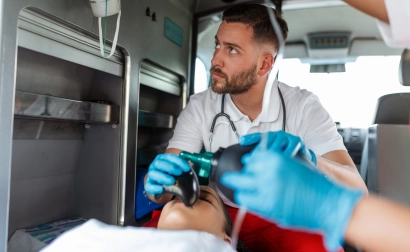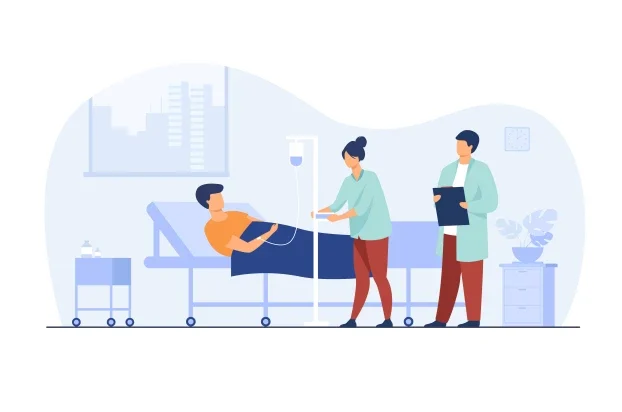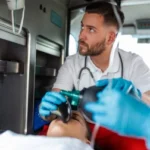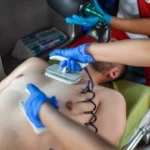
The Role of Ambulance Services in Saving Lives During Critical Hours
Every second matters when it comes to medical emergencies. Whether a patient receives prompt treatment during those crucial hours that could mean the difference between life and death is frequently determined by how quickly an ambulance arrives. Ambulance services do much more than just transport patients; they stabilize patients, offer critical pre-hospital treatment, and guarantee a safe transfer to medical institutions. With cutting-edge features like critical care ambulances and life-saving tools like ventilators in ambulances, these services have grown to be an essential component of contemporary healthcare, providing prompt assistance when it counts most.
Understanding the Role of Ambulance Services

The foundation of emergency medical response is ambulance services. Providing prompt medical attention at the scene of an emergency and while in transit is their main responsibility in addition to patient transportation. Ambulances with paramedics, nurses, or even physicians on board make sure that vital treatments start before the patient even gets to the hospital.
Accidents, heart attacks, strokes, trauma cases, and respiratory distress are just a few of the many crises that modern ambulance services are prepared to address. Ambulances can serve as critical care ambulances with advanced amenities or as basic life support (BLS) units, depending on the severity.
Role of ambulance services fill the critical gap between the start of a medical emergency and the availability of hospital treatment by providing quick response, ongoing monitoring, and life-saving equipment like ventilators, defibrillators, and oxygen assistance.
Rapid deployment is a top priority for ambulance transport services, which frequently use GPS monitoring and carefully positioned cars to get to patients fast, no matter the distance or traffic. These services promise a prompt reaction to reduce risks and problems, whether it’s a vehicle accident, cardiac arrest, or any other unexpected medical issue.
Additionally, medical personnel and trained paramedics on board are prepared to offer prompt care while in motion, stabilizing patients as they are being transported to the hospital. A competent ambulance service is crucial for saving lives because of its prompt arrival and expert medical care.
Knowing that dependable and timely assistance is available gives families looking for an ambulance service online peace of mind during extremely trying times. Safe and effective hospital transfers are ensured by prompt response times and professional care.
Critical Hours: Why Time Matters Most
Time is the most important resource in any medical emergency. Physicians sometimes talk about the “golden hour,” which is the critical first sixty minutes following a serious injury or medical emergency, during which prompt action can significantly improve survival rates and lower long-term problems. This is the point at which role of ambulance services can save lives.
Ambulance crews are prepared to react rapidly, stabilize patients on the spot, and guarantee a safe journey to the hospital. Every minute that passes without appropriate care for diseases including acute respiratory failure, cardiac arrest, stroke, or accidents can cause lasting harm.
The role of ambulance services guarantees that no time is wasted during these crucial hours by providing quick access to medical care, cutting-edge monitoring, and equipment like oxygen support and defibrillators. Their promptness and readiness frequently make the difference between life and death.
Critical Care Ambulance: Advanced Support on the Move
A typical ambulance cannot handle every medical emergency. Advanced facilities that simulate an intensive care unit (ICU) on wheels are necessary in some circumstances. The critical care ambulance, which is intended to offer patients in life-threatening situations specialized support, can help in this situation.
Advanced medical equipment including defibrillators, infusion pumps, cardiac monitors, and ventilators for patients who are unable to breathe on their own are all included in critical care ambulances. In order to stabilize patients while in travel, it also transports emergency medical supplies and life-saving medications.
Highly skilled paramedics, nurses, or critical care physicians who are capable of performing cutting-edge interventions while in route typically staff these ambulances. They are crucial for moving patients who need post-surgery transfers, have heart attacks, strokes, severe injuries, or organ failure.
The role of ambulance services, especially critical care ambulances, play a crucial role in ensuring that patients receive continuous, high-quality treatment until they reach a hospital by combining sophisticated ICU-level care with quick mobility. This greatly increases the likelihood that patients will survive emergencies.
The Importance of a Ventilator in an Ambulance
Helps patients who have trouble breathing, which is crucial for those who are unable to breathe on their own because of trauma, respiratory failure, or cardiac arrest.
Guarantees a steady flow of oxygen during transportation, avoiding abrupt reductions in oxygen levels.
Maintaining patient stability during inter-hospital transfers or emergency transport from a rural area to a city is crucial for long-distance transfers.
Supports critical care ambulance services by ensuring ICU-level care while on the go by combining with other cutting-edge devices like monitors and defibrillators.
Lowers risk of complications and provides prompt ventilatory support lowers the chance of delayed oxygenation leading to organ damage or death.
Essential in times of mass emergencies helps several patients who require breathing support in the event of an accident or natural disaster.
Key Features That Enhance Life-Saving Efficiency
The role of ambulance services is highly specialized mobile units created to provide vital medical aid when time is of the essence; they are more than just vehicles for patient transport. Their ability to save lives depends on a number of factors, including highly skilled personnel, cutting-edge medical equipment, and excellent hospital coordination.
The presence of trained medical professionals, including paramedics, nurses, and emergency technicians, is one of the most important aspects. Quick assessments, first aid, CPR, hemorrhage control, and even advanced life support until the patient gets to the hospital are all skills that these experts are educated in. Their knowledge greatly increases the likelihood of surviving and offers instant comfort.
The presence of contemporary life-saving equipment in ambulances is equally crucial. While ventilators in ambulances guarantee that patients with respiratory failure receive continuous oxygen assistance, devices such as defibrillators aid in restoring normal heart rhythms following cardiac arrests. Suction machines, stretchers, cardiac monitors, and infusion pumps are a few more devices that improve patient stability while being transported. Particularly when it comes to critical care ambulances, these characteristics make ambulances similar to mobile intensive care units.
Smooth communication systems are another important factor. Modern ambulances have hospital communication networks and GPS, which enables paramedics to provide doctors with real-time updates. By doing this, hospitals can save valuable time during crucial hours by making sure they have the required facilities, equipment, and specialists ready when the patient arrives.
The patient’s chances of survival increase with the speed at which an ambulance arrives. These days, a lot of ambulance services cover both urban and rural areas, are open around-the-clock, and use technology to create effective dispatch systems that reduce delays.
These characteristics—trained personnel, cutting-edge medical technology, reliable communication systems, and quick reaction—collectively characterize ambulance services as life-saving assets. They offer prompt, effective, and continuous medical assistance that frequently makes the difference between life and death by bridging the gap between the emergency scene and hospital care.
The Role of Ambulance Services Beyond Transportation
These days, the role of ambulance services do much more than just transport patients from one location to another. They provide prompt assistance that can stabilize patients before they ever get to the hospital, making them the initial point of medical care. Critical care starts as soon as possible thanks to the important treatments provided by trained paramedics and emergency technicians, who can conduct CPR, check vital signs, stop bleeding, and deliver oxygen.
Expert personnel and cutting-edge equipment can boost confidence and lessen anxiety in high-stress scenarios like accidents, cardiac arrests, or respiratory failures.
Improving access to healthcare is also very important, particularly in rural or isolated areas where hospitals may be far away. These services make sophisticated healthcare more available to everyone, no matter where they live, by bridging the distance with critical care and rapid response ambulances that are outfitted with ventilators, defibrillators, and other life-saving equipment.
Ambulances are also essential in mass catastrophes and disaster management, where prompt evacuation and medical attention are critical. They assist save numerous lives by ensuring that patients are handled in a safe, orderly, and effective manner in chaotic conditions.
Essentially, ambulance services serve as mobile emergency units, comforting resources, and vital links between patients and hospitals, guaranteeing prompt and comprehensive care during life’s most pressing emergencies. Their mission extends much beyond simple transportation.
Conclusion
The role of ambulance services play a far larger role in contemporary healthcare than just transporting patients. These mobile life-saving units are outfitted with highly skilled medical personnel, cutting-edge equipment, and communication systems to guarantee that patients receive emergency care at the most crucial times. These services can be the difference between life and death in emergency situations, from providing prompt medical attention to giving specialist support through critical care ambulances and necessary equipment like a ventilator in an ambulance.
Ambulance services ensure prompt, effective, and ongoing care by bridging the distance between the scene of an incident and the hospital. Their influence goes beyond medical; they provide rural communities with accessibility, emergency preparedness, and family reassurance. In the end, trustworthy ambulance services are among the most solid foundations of emergency medical care, demonstrating that every second matters when it comes to saving lives.




